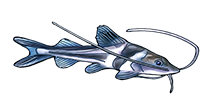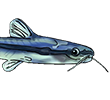pronunciation
pronunciation
Now that I own them I should be able to say the name correctly. Recently purchased 2 Synodontis dhonti- how do you pronounce dhonti?
Thanks,
Tom
Thanks,
Tom
Id
Can't post pics. You mean as opposed to tanganyicae? I'm 90% sure on the 7" one. The other is 2-3" and it's 50/50 as far as ID. The reason I say both are dhonti is they were collected in same location. Are both species found together in nature?
Take care,
Tom
Take care,
Tom
- Sid Guppy
- Posts: 757
- Joined: 31 Dec 2002, 15:36
- Location 1: Brabant, the Netherlands
- Interests: Catfish, Tanganyikan fish, Rock'n'roll, Fantasy
AFAIK those two species, as well as granulosus roam the entire lake, and have few, if any local varieties. It probably comes with the size of the adults. Most -not all!- other Tangies that pass the 1foot mark haven't got those either.
Maybe their huge territories or wanderlust mix up the population?
If they share the exact habitat I don't know, but it's likely. They're not so specialized as polli (snaileater) or multipunctatus, wich needs hosts to breed.
Those -as well as the petricola (another specialized feeder?)- have habits that binds them to certain habitats or need certain hosts that stick to one. And those species have many well-known varieties/subspecies.
Maybe their huge territories or wanderlust mix up the population?
If they share the exact habitat I don't know, but it's likely. They're not so specialized as polli (snaileater) or multipunctatus, wich needs hosts to breed.
Those -as well as the petricola (another specialized feeder?)- have habits that binds them to certain habitats or need certain hosts that stick to one. And those species have many well-known varieties/subspecies.
Plan B should not automatically be twice as much explosives as Plan A
- Dinyar
- Posts: 1286
- Joined: 31 Dec 2002, 00:34
- My articles: 3
- My images: 226
- My catfish: 10
- My cats species list: 3 (i:10, k:0)
- Spotted: 94
- Location 1: New York, NY, USA
- Interests: Mochokidae, Claroteidae, Bagridae, Malepteruridae, Chacidae, Heteropneustidae, Clariidae, Sisoridae, Loricariiadae
Erwin Scraml maintains that there are >1 species called "S. tanganaicae" (personal communication, don't know if he mentions this in his recent DATZ article, which I have yet to see).
I think we all agree that there's a "Northern" and "Southern" S. multipunctatus, and multiple varieties/species of S. petricola. The jury appears to still be out on the question of whether there are multiple varieties/species of S. polli.
Dinyar
I think we all agree that there's a "Northern" and "Southern" S. multipunctatus, and multiple varieties/species of S. petricola. The jury appears to still be out on the question of whether there are multiple varieties/species of S. polli.
Dinyar
- Sid Guppy
- Posts: 757
- Joined: 31 Dec 2002, 15:36
- Location 1: Brabant, the Netherlands
- Interests: Catfish, Tanganyikan fish, Rock'n'roll, Fantasy
so far the true polli and the "polli white Zambia" stand a fair chance.
unless -wich wouldn't surprise me at all- "polli white Zambia" turns out to be completely unrelated to polli and is a whole new species standing on its' own.
they definitely don't look like each other one bit once adult, save the color of the teeth wich is bright orange.
but AFAIK dhonti has orange teeth as well....
unless -wich wouldn't surprise me at all- "polli white Zambia" turns out to be completely unrelated to polli and is a whole new species standing on its' own.
they definitely don't look like each other one bit once adult, save the color of the teeth wich is bright orange.
but AFAIK dhonti has orange teeth as well....
Plan B should not automatically be twice as much explosives as Plan A




